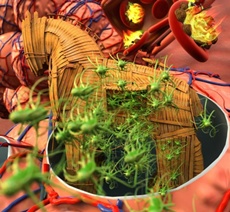A paradigm shift in multidrug resistance
24 Aug 2015
Michael Mahan discovers an unexpected resistance mechanism in pathogenic bacteria that may warrant changes in the way antibiotics are developed, tested and prescribed
 | |
| Bacteria switch between antibiotic susceptible-to-resistant states during infection using a Trojan horse strategy. / Photo Credit: Peter Allen |
Bacteria are pretty wily creatures. Take for example, an organism such as Salmonella, which which are killed by antibiotics in lab tests, but can become highly resistant in the body.
It is an example of what University of Californiaat Santa Barbara (UCSB) biologist Michael Mahan refers to as the Trojan horse strategy.
Identified through new research conducted by Mahan and his colleagues, the Trojan horse strategy may explain why antibiotics are ineffective in some patients despite lab tests that predict otherwise. The research findings appear in the journal EBioMedicine.
"We are not petri plates, and we need to revisit the way antibiotics are developed, tested and prescribed," says Mahan, a professor in UCSB's Department of Molecular, Cellular, and Developmental Biology. Current methods for testing resistance to antibiotics do not reflect the actual and varying environments in the body, where bacteria fight to survive. Mahan noted that this difference can render antibiotic susceptibility testing inaccurate.
"Prescription of the wrong antibiotic may not only fail to clear the infection but may create the perfect storm for the emergence of superbugs in infected patients," he added. "Even in our most advanced hospitals, high drug doses are given to infected patients without knowing that the body's environment may render bacteria inherently resistant to the very antibiotics prescribed to control them."
Mahan's research demonstrates two important points: - bacteria become resistant only to certain antibiotics, and they deploy this defense mechanism only in certain areas of the body.
This means that when a patient fails to respond to a particular course of antibiotics that lab tests predict should be effective, rather than increasing the dose or duration of treatment, a potentially more effective therapeutic option is simply to prescribe another drug.
Mahan and his colleagues initially worked with the aforementioned Salmonella, a bacterium that causes food and blood poisoning. Salmonella reside within white blood cells -- the very cells of the immune system that are involved in protecting the body against infectious disease. When the researchers mimicked this intracellular environment in the lab, the bacteria became highly resistant to certain antibiotics.
Next, the researchers tested Yersinia, a bacterium that also causes food and blood poisoning but lives outside of host cells in the intestine. When researchers mimicked the extracellular environment of the intestine, this bacterium also became highly resistant to certain antibiotics.
These two examples indicate that the resistance process may be shared by many different types of bacteria.
"Our research suggests the need for animal models to be incorporated early during the antibiotic development process and for lab drug sensitivity testing to incorporate media that mimic the specific biochemical environments that trigger resistance in the body," Mahan explained. "If these additional components were added, we'd get a more accurate reflection of what happens when a patient is treated with a particular drug.
"An exciting potential outcome of this research is that the next wonder drug to treat multidrug-resistant superbugs may already exist at pharmaceutical companies, which store millions of chemical compounds," Mahan added. "Some of these compounds may have been excluded as antibiotics since they did not kill bugs efficiently on petri plates, but they may work well in treating patients with multidrug-resistant infections."
The lead authors of the paper are Jessica Kubicek-Sutherland, a former graduate student in the Mahan lab who is now a postdoctoral fellow at Uppsala University in Sweden, and Douglas Heithoff, a project scientist at the campus's Center for Nanomedicine.
Additional UCSB co-authors include Selvi Ersoy, a graduate student in the Mahan lab, and Jamey Marth, director of the Center for Nanomedicine and a MCDB professor. William Shimp, projects manager of ICON Clinical Research in La Jolla, California; John House of the University of Sydney in Australia; and Jeffrey Smith of the Sanford-Burnham Medical Research Institute in La Jolla, California, are also contributors.
This work was supported by the G. Harold and Leila Y. Mathers Foundation, the Santa Barbara Cottage Hospital Research Program, the National Institutes of Health and a National Science Foundation Graduate Fellowship.













.jpg)






.jpg)









